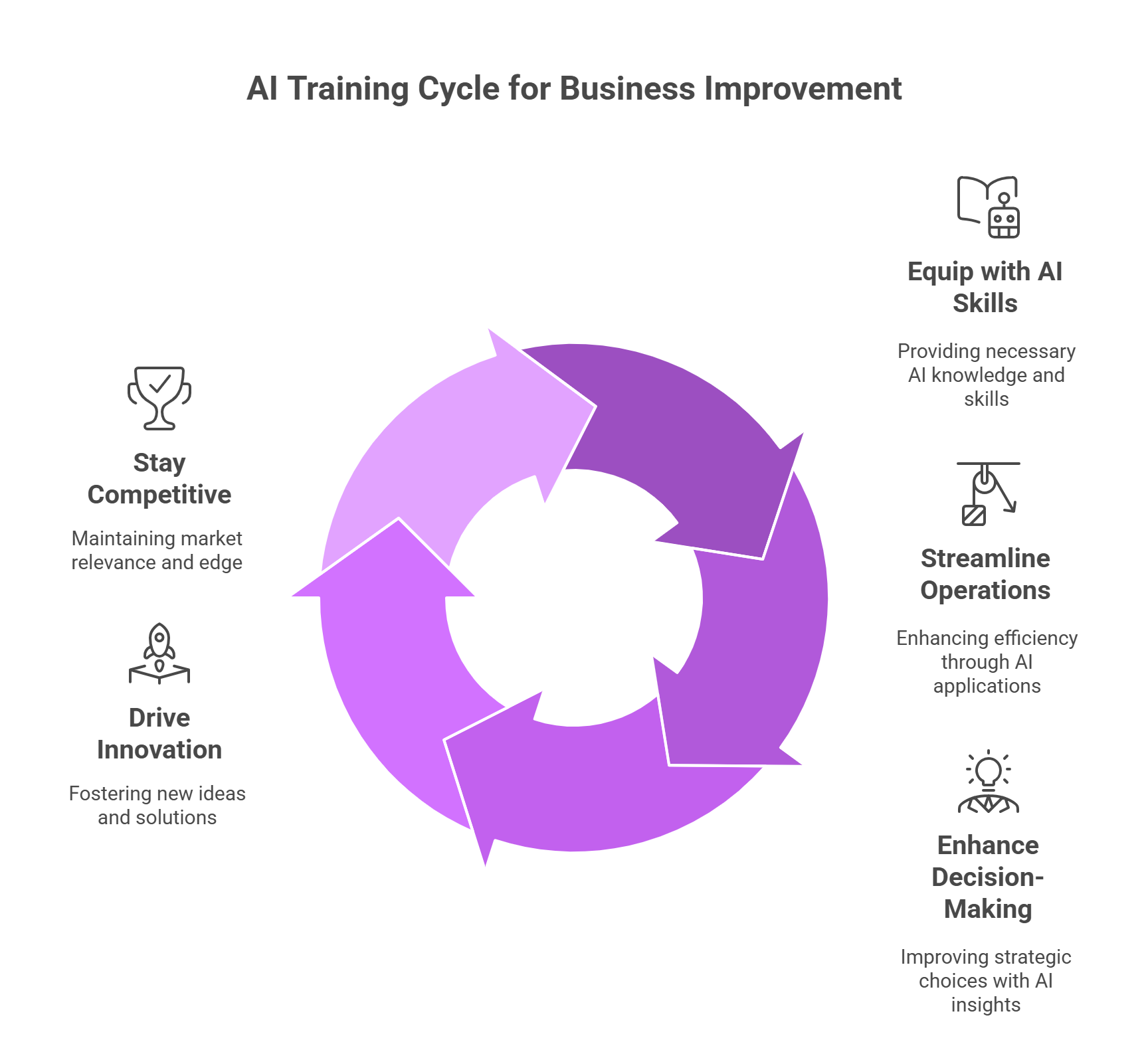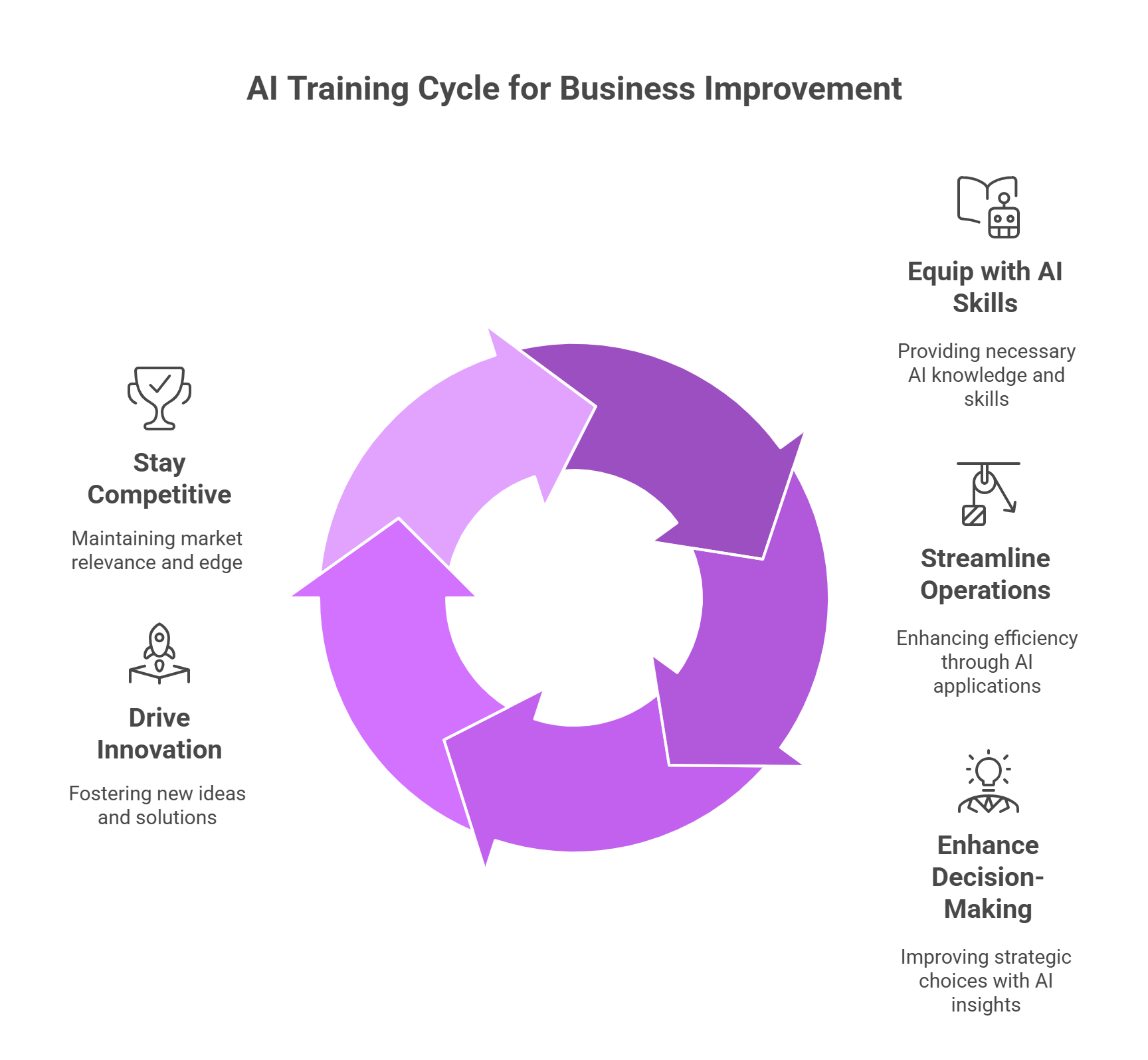
Training companies to work with artificial intelligence that improves your business.
The rapid integration of artificial intelligence into the corporate landscape represents one of the most significant operational shifts in modern business history. The technology’s promise of enhanced productivity, data-driven insights, and competitive advantage has spurred a race to adoption. Analysis reveals that AI is already being implemented in an estimated 93% of workplaces in the United States. However, this aggressive technological deployment has exposed a critical and widening vulnerability: the AI readiness gap.
While organizations are quick to invest in AI tools, a corresponding investment in human capital is dangerously lagging. According to recent surveys, only 49% of Chief Human Resources Officers (CHROs) report that their organizations are currently prioritizing training in AI and data analysis. Even among companies with the most aggressive AI spending plans, this figure only rises to 57%.
This chasm between tool adoption and workforce capability is not a minor discrepancy; it is a primary driver of unrealized value and a significant source of organizational risk. The consequences manifest as underutilized AI systems, inefficient processes, and outright implementation failure. This guide serves as a strategic framework for understanding the corporate AI training market, evaluating provider capabilities, and implementing an upskilling program that mitigates risk and delivers measurable business improvement.

Section 1: A Strategic Framework for AI Competency
To achieve a meaningful return on investment from artificial intelligence, organizations must move beyond traditional software training. A sophisticated approach is required—one grounded in a structured framework that builds genuine competency.
The AI Skills Pyramid 🧠
Based on established pedagogical principles, skill acquisition is a hierarchical process. Before an employee can innovate with AI, they must first understand its fundamental concepts. The AI Skills Pyramid provides a clear roadmap for developing proficiency:
- Knowledge: The foundational level of awareness. An individual has heard of AI concepts like ChatGPT but has no practical experience.
- Understanding: Learners move from passive awareness to active engagement. They begin to experiment with AI tools, perhaps using a large language model (LLM) to summarize a document.
- Application: The crucial inflection point where tangible business value emerges. A professional can confidently use AI tools to achieve desired outcomes in their daily work. This is the minimum target proficiency for the general workforce.
- Mastery: The apex of the pyramid. Individuals can strategize and innovate with AI, designing new workflows and leading complex initiatives. This is essential for AI champions and leadership.
The AI Habits Pyramid: The Key to Integration 🏋️♀️
Possessing a skill is useless if it is never used. The gap between acquiring a skill and forming a habit of using it is where the ROI of training is lost.
- Awareness: Knowing a tool exists but not actively using it.
- Occasional Use: Experimenting with AI for isolated tasks but without fundamentally changing core work processes.
- Integration: The primary goal for most employees. AI becomes an essential and regular part of the professional’s toolkit, leading to measurable improvements in speed and quality. The employee is now an “AI-powered professional.”
- Advocacy: The final stage where individuals become internal champions, mentoring colleagues and driving broader adoption.
By mapping these competency frameworks to specific business objectives—for instance, aiming for “Application” and “Integration” for the general workforce—a company can select a training program that delivers strategic results.
Section 2: Mapping the AI Training Provider Landscape
The market for corporate AI training is a diverse ecosystem. Understanding the primary categories of providers is essential for finding the right partner.
1. Corporate Training Specialists
These firms are experts in pedagogy and corporate learning. They design and deliver customized, enterprise-level solutions.
- AI Academy: Focuses on scalable adoption and turning team members into AI champions.
- Improving: Offers tool-agnostic workshops for roles from executives to engineers.
- Noble Desktop: Known for hands-on, customizable training delivered online or onsite.
- Edstellar: A global provider with a vast course catalog and a platform for managing training initiatives.
2. Major Technology Platforms (The “Big Three”)
The architects of foundational AI ecosystems—Amazon Web Services (AWS), Google Cloud, and Microsoft—offer training focused on their specific platforms. This is indispensable for technical teams and often leads to industry-recognized certifications.
- Microsoft Learn
- Google Cloud Skills Boost
- AWS Skill Builder
3. University-Affiliated Executive Programs
Elite academic institutions offer high-level, strategy-focused courses tailored for senior business leaders, emphasizing business model transformation and ethical governance.
- Harvard Business School (HBS) Online: Features its case-method-based “AI Essentials for Business” course.
- Stanford Online: Offers programs like “AI-Driven Leadership.”
- Wharton School (University of Pennsylvania): Provides an “AI for Business” specialization via Coursera.
4. Online Learning Platforms (MOOCs)
Massive Open Online Course (MOOC) providers offer scalable, flexible, and often self-paced learning solutions, ideal for individual upskilling or foundational training.
- Coursera for Business: Hosts courses from partners like IBM, DeepLearning.AI, and Google.
- Skillsoft: Provides a comprehensive enterprise platform including courses, labs, and access to Codecademy.
5. Niche & Compliance-Focused Specialists
This category includes providers that target specific business functions or regulatory requirements.
- NAVEX: Specializes in the legal, risk, and compliance aspects of AI, offering training on ethics and regulations like the EU AI Act.
A key distinction exists between platform-centric training (from the Big Three) and pedagogy-centric training (from specialists and universities). If the goal is deep expertise in a specific tech stack (e.g., Azure AI), a platform-centric provider is logical. If the objective is to shape enterprise-wide strategy in a tool-agnostic way, a pedagogy-centric provider is a better fit.
Section 3: Comparative Analysis of Training Programs by Audience
A successful AI upskilling initiative cannot be one-size-fits-all. Training must be tailored to the distinct needs of each audience within the organization.
For the C-Suite and Executive Leadership The focus is on strategy, governance, and ROI.
- HBS Online’s “AI Essentials for Business” uses the case method to explore AI-powered business models.
- AI Academy’s “Executive Workshops” offer straight talk on realistic AI strategy.
For Mid-Level Leaders and Managers This group bridges vision and execution.
- AI Academy’s “AI Changemaker Bootcamp” equips managers to become internal champions who drive adoption.
- Improving’s “AI Discovery Workshop for Leaders” explores how AI can accelerate team productivity.
For the General Workforce (All Professionals) The goal is foundational literacy and practical productivity.
- Noble Desktop’s “AI for Workplace Productivity with Microsoft Copilot” teaches skills for immediate application in Office 365.
- Coursera’s “AI For Everyone” from DeepLearning.AI is a popular non-technical introduction.
For Technical Specialists (Engineers, Data Scientists) This requires deep, platform-specific training.
- Improving’s “AI/ML for Software Engineers” teaches developers how to apply machine learning in corporate settings.
- AWS, Google Cloud, and Microsoft offer essential certification paths like the “AWS Certified Machine Learning Engineer” and “Designing and Implementing an Azure AI Solution.”

The following table summarizes these offerings:
| Target Audience | Provider Example | Program Example | Core Curriculum Focus | Key Outcome/Certification |
| C-Suite & Executives | HBS Online | AI Essentials for Business | Strategic ROI, Governance, Business Model Transformation | Certificate of Completion |
| Mid-Level Leaders | AI Academy | AI Changemaker Bootcamp | Leading AI Initiatives, Driving Adoption, Functional Strategy | Internal AI Champion Skills |
| General Workforce | Noble Desktop | AI for Workplace Productivity with Microsoft Copilot | Foundational Literacy, Prompting, Using Integrated AI Assistants | Practical Productivity Skills |
| Marketing Teams | Noble Desktop | AI for Marketing Bootcamp | SEO, SEM, Social Media Automation, AI-driven Content Creation | Functional Specialization |
| Technical Specialists | AWS | AWS Certified Machine Learning Engineer | Platform-Specific Model Building (SageMaker), MLOps | Industry-Recognized Certification |
Section 4: Deep Dive into Curricula and Investment
The effectiveness of any training program hinges on its curriculum and the investment required.
Curricula: From Foundational to Functional
- Foundational Literacy: For most employees, this involves practical skills in generative AI. Noble Desktop offers 6-hour workshops in
ChatGPTandMicrosoft Copilot. Skillsoft and Google provide introductory courses on prompt engineering and responsible AI use. - Strategic AI: Executive curricula focus on business implications. HBS Online’s “AI Essentials for Business” guides leaders through strategy, ethics, and transformation.
- Functional AI: Training must be tailored to departments. Noble Desktop’s “AI for Marketing Bootcamp” covers SEO and automation, while Wharton’s courses on Coursera address AI in finance (fraud detection) and HR (mitigating bias).
- Advanced Technical: Curricula from Microsoft, AWS, and Google are essential for engineering teams, covering platform-specific tools like Azure AI Studio, Amazon SageMaker, and Google Vertex AI.
Investment Analysis: Deconstructing Costs and Projecting ROI
Pricing models vary significantly, impacting the total investment.
| Provider Category | Common Pricing Model | Estimated Cost Range | Key Value Proposition |
| Online Learning Platforms | Per-User Subscription | $299 - $500 / user / year | Scalability, Cost-Effectiveness, Large Catalog |
| Corporate Training Specialists | Custom Enterprise Package | $25,000 - $250,000+ per project | High-Touch Service, Deep Customization, Pedagogical Expertise |
| University-Affiliated Programs | Per-Course Tuition | $1,850 - $2,650 per course | Prestige, Strategic Framing, Networking |
| Tech Giants | Certification & Partnership Fees | Often bundled or priced per exam/course | Ecosystem Integration, Industry-Recognized Certifications |
Building the business case for this investment requires quantifying the ROI through:
- Direct Cost Savings: Replacing expensive software subscriptions with custom-built internal AI tools.
- Productivity Gains: Calculating the financial value of time saved. Microsoft’s case studies show clients saving over 800 employee hours per month with Copilot.
- Risk Mitigation: Viewing compliance training from providers like NAVEX as an insurance policy against costly regulatory fines and reputational damage.
Section 5: A Roadmap for Successful Implementation
Selecting a vendor is only the first step. Successful deployment is a change management project requiring careful planning and execution.
Choosing the Right Delivery Model
Top-tier providers like Noble Desktop and Edstellar offer a full spectrum of options:
- Onsite Training: Best for immersive, collaborative team learning.
- Live Online (VILT): Offers real-time instructor interaction for geographically distributed teams.
- Self-Paced Online: Provides maximum flexibility but requires high learner motivation.
- Blended Learning: A hybrid approach, often combining self-paced theory with live online practice, is considered the most effective.
The Critical Role of Customization
Generic content rarely has the impact of a tailored program. Leading providers like Noble Desktop and NAVEX offer consultations to create custom curricula that incorporate a company’s own datasets, policies, and real-world examples, dramatically increasing relevance.
Building a Culture of Adoption
The ultimate goal is to change behavior.
- Create Internal Champions: Use programs like AI Academy’s “AI Changemaker Bootcamp” to cultivate a network of internal advocates who can drive organic adoption.
- Embed Governance and Responsible AI: Trust is essential. Training must cover data privacy, security, and mitigating bias.
- Share Success Stories: Make the benefits tangible. Use internal channels to allow employees to share peer-to-peer examples of how AI improved their daily work, fostering a virtuous cycle of discovery.
Final Assessment: Building a Continuous Learning Culture
The pace of AI advancement is relentless, making a “one-and-done” approach to training obsolete. The ultimate goal should be to build an organizational culture of continuous learning. A successful initiative will equip the workforce not just with proficiency in today’s tools, but with a foundational understanding of AI principles and the mindset to adapt as the technology evolves. The most significant long-term competitive advantage will belong not to the companies that are first to adopt AI, but to those that become the fastest and most effective at learning how to leverage it.

